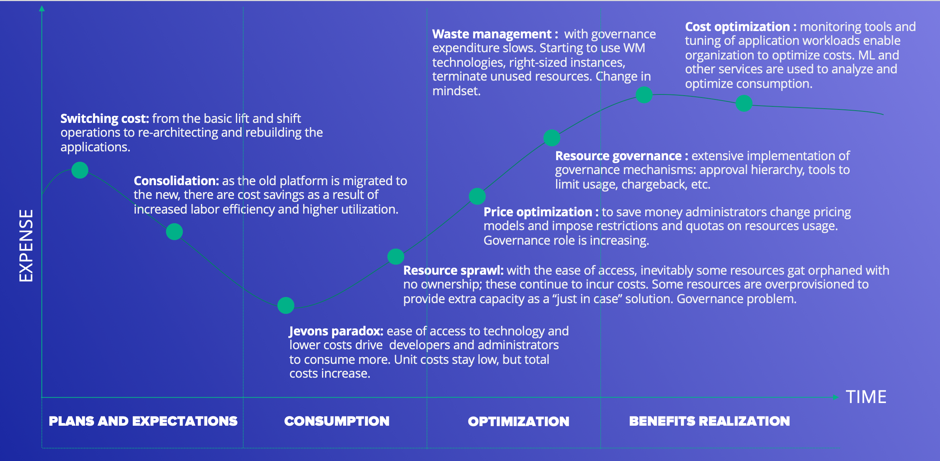If you plan the Cloud Transformation
My experience with cloud transformations shows they are truly special projects. We’ve helped many clients adopt and manage their clouds. Mostly they were enterprise clients, but some were small and medium businesses. And we’ve noticed a few factors that make cloud adoption and management projects distinctly different.
First and foremost, it changes the way the organization operates. For digital and non-digital organizations, all the same. Suddenly we do not have a team that does only Virtual Machine provisioning, maintenance, and decommissioning; or a Puppet team. We have a whole different setup and processes are different. It changes the mindset of almost all people and forms new ways for people to do their work.
Organizations that underestimate the complexity of cloud transformation projects pay a very high price.
Most of the organizations have already begun the cloud-adoption journey. To keep things simple in this article, we will talk about cases of launching projects and programs in an organization that has already had some cloud implementation experience. As well, further, I will talk about programs because most of the time cloud transformation is a family of programs rather than projects. We usually have projects that focus on setting up the infrastructure and migrating data; and some that are migrating and enhancing applications, support teams, SecOps performing security assessments and improvements, etc.
So, if you find yourself planning to start a program within a cloud transformation portfolio I’d recommend you answer these questions first:
- Where you are in the cloud transformation journey and what the next steps are.
- Do you have all necessary stakeholders in place?
- Are there any gaps in organization IT maturity and applications maturity?
- What is your organization readiness-to-change level?
The cloud transformation journey
There are a few phases that each company would go through during the cloud digital transformation:
- Plans and expectations phase. We’ve heard about cloud and how magically it rockets value and success to the sky. We’ve spoke with cloud providers and experts. It all seems really exciting. We’ve prepared and migrated some of the assets to the cloud, mostly lift and shift. But even in this basic form, it allowed us to gather everything together and reduced lead times and costs. At this phase, it is important to plan the waste management and governance because of what the next phase will bring us.
- Consumption phase. The infrastructure resources have become a lot more accessible. It is very easy to spin the resources and it takes minutes instead of weeks we had before. So, the consumption grows. Now it is important to educate all the involved stakeholders about the cloud consumption rules. It is usually a good idea to start thinking about redesigning some application toward the cloud native approaches that allow you to consume more and provide more control over the consumption. At this phase, you definitely have a cloud team. But you also have to have a security and governance team. Some of our apps will go to production and compliance and security are very important.
- Optimization phase. If everything was done right in the previous steps of the journey, this step shouldn’t be a problem. You have our governance teams in place, your cloud spend controlling mechanisms, and you educated your stakeholders well. Now you just need to think about automated governance. Because as we grow, the governance can and most likely will become a bottleneck. This is time to change the architecture if the applications to cloud native . And now we think how efficiently to manage a hybrid cloud, not just to have silos of applications in different clouds, but also establish intelligent data and workload mobility and management, and smart failover prevention.
- Benefits realization. I guess you did everything right on the previous steps, now it is time to start getting real value from the digital transformation.
Please see the chart below:

Why is it important to understand where we are? If you know where you are, you can plan and manage risks correctly.
Required stakeholders
This is another important part of the assessment you perform in order to plan the program. And often it is a reason why some cloud transformation programs fail. The stakeholders we need are:
- Business groups representatives. People who represent the business functions (sales, finance, etc.).
- Security and Governance teams.
- Cloud Partner representatives.
- Cloud teams(s).
- Functional teams.
- Applications teams.
- Data management and data analytical teams.
We will talk about cloud-program stakeholder management in another article, but for now, it is important that you identify and manage these stakeholders in your program.
Organization IT maturity
There are many ways to assess the organization’s general IT maturity. We concluded by using the ladder described below.
1. Ad-hoc:
- Processes not specified,
- Individuals determine,
- Reinvent the wheel every time,
- Struggles to keep up with demand.
2. Repeatable:
- Teams establish processes,
- Little cross-discipline activity,
- Repeatable within team,
- Inconsistent prioritization and slow delivery.
3. Defined:
- Processes defined and documented,
- Becoming agile,
- Processes consistently followed across the organization,
- Synergy among discipline strengthens, interdependency emerges,
- Formal application strategy.
4. Agile:
- Clear agile culture,
- Content employing emerging application architecture,
- Application strategy segmented by pace of change,
- Interdependency among disciplines is essential.
5. Continuous:
- Anticipate technology and industry trends,
- Creative and collaborative culture,
- Capabilities of continuous delivery,
- Rapid ability to adjust strategy and plans.
Applications maturity
Another important dimension of the assessment you’re going to make is application maturity. I guess this is the most practical part of it because this will actually drive the scope of your program in many ways. So be sure to review:
- SDLC methodology application teams are using to develop, test, and deploy functionality.
- Requirements management methodologies and approaches teams are using.
- Application architecture and design.
- Development practices.
- Testing practices.
- CI/CD process.
- Operations (DevOps, SecOps, etc.).
The assessment of the current level of applications maturity will give you the “As is” picture. When you perform such an analysis, it will become clear where the low-hanging fruit is located where you can improve right away, as well as where strategic changes could be made that will become the game-changer for your business.
When you understand the stage of cloud transformation that your company is in, you can understand what the challenges are, what are the next steps, and what is important. When your organization’s maturity assessment is performed, you will understand risks and challenges. You know how to manage your stakeholders and their expectations. And you understand the difference between global “As is” and “To be” states. The application maturity assessment will help you understand the scope, challenges, and risks.
There is one very important thing to consider before you develop the project and program plans: the organization’s readiness to change. This is a topic for a separate article I will be sharing shortly so will not go there too much right now.
Plan
Now you can develop projects plans as well as program benefits realizations, create detailed program roadmap, KPIs and/or OKRs, risks and assumptions, stakeholders, the management of their expectations, and many other important things.
The work breakdown structure could be very different in each case. If we consider the ideal cloud adoption digital transformation program, it will consist of 6 steps, as described below.
1. Asses.
- Perform application and infrastructure maturity assessment.
- Divide application into 3 buckets:
- easy to move (lift and shift)
- hard to move (upgrade)
- can’t move (rebuild)
- Define 6R strategy: Retire, Retain, Rehost, Repurchasing, Replatforming, Refactoring.
2. Prepare.
Plan the migration. Make sure to plan the following aspects:
- infrastructure setup,
- automation,
- cloud governance set-up,
- data migration,
- application migration,
- refactoring and re-architecting,
- organizational change management,
- support.
3. Pilot
Pilot is essential because it provides empirical data for validation of major planning parameters (velocity, focus factor, delays, etc.).
4. Move data.
Data is core for migration. As well, it can be one of the most complex parts of migration. Data is migrated prior to the migration of applications.
5. Move applications.
Move applications in close collaboration with application and functional teams.
6. Optimize.
When the first bucket of data and applications in moved to the cloud, there often is an overprovisioning problem. So, optimization is an essential part of migration. Here are a few aspects:
- resource usage optimization,
- governance and quotes,
- monitoring,
- etc.
There are many important details that are out of the scope of this article. And I will continue writing about them in the future. As for this one, the information here will help you plan the successful delivery of your cloud transformation program.


